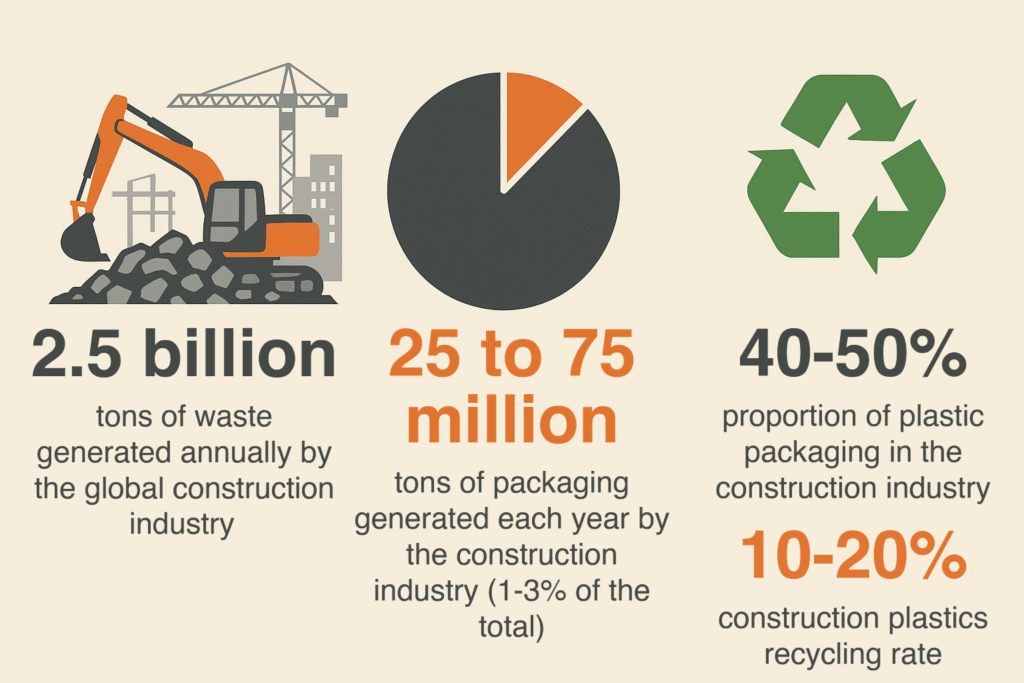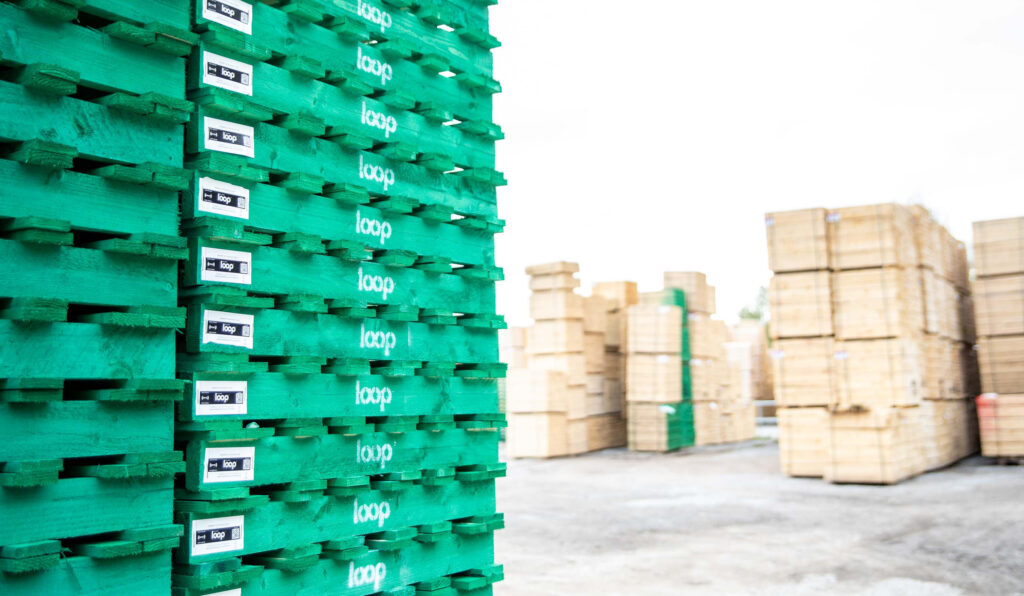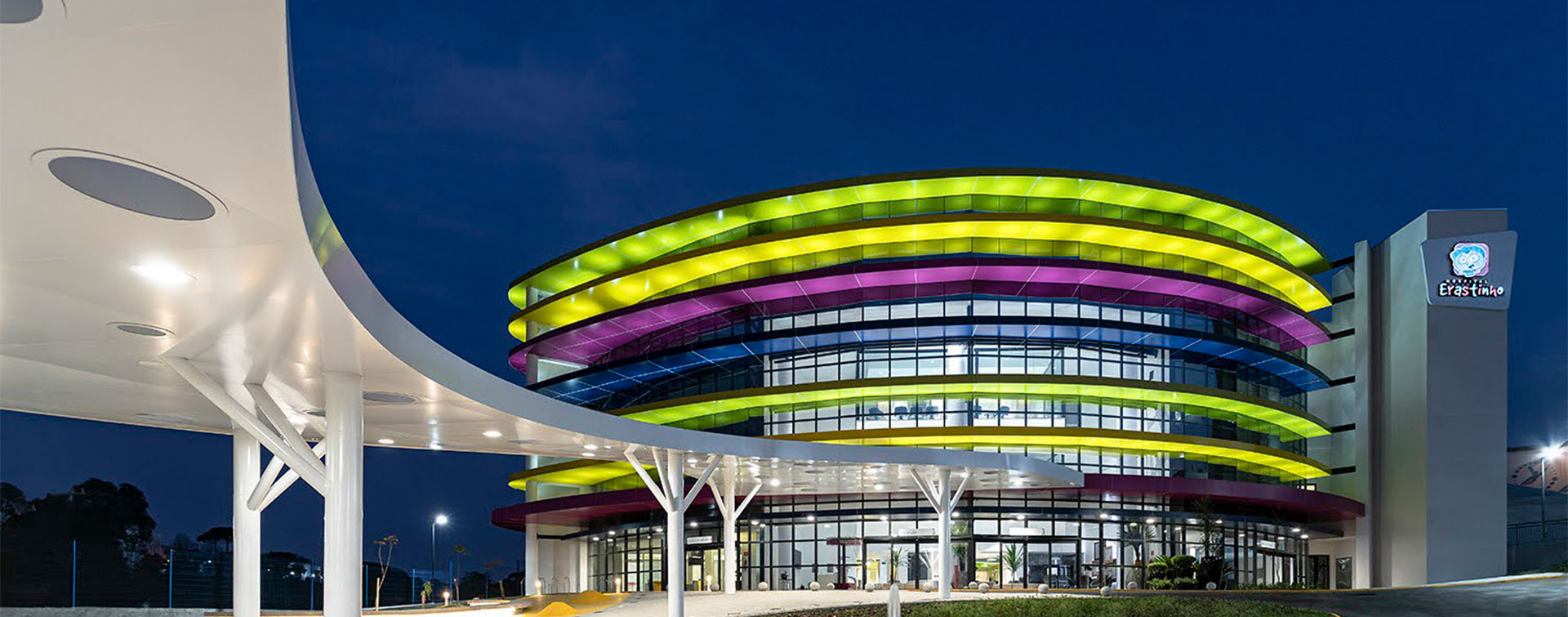 9 min
9 min
Worldwide, packaging generates 22.7 billion tonnes of CO₂ per year. (1) The construction sector contributes to this footprint through its high consumption of packaging material: plastic film for insulation, bags for plaster, mortar and cement, containers for chemicals, etc. Unlike the food industry, where there are structured channels for collecting household packaging, the building and public works sector suffers from unsatisfactory sorting and limited recycling of its packaging. Yet solutions do exist to make packaging and its use more sustainable.
Current state of play: a quantified issue, but under-exploited
The figures reveal the scale of the challenge. The construction sector generates around 2.5 billion tonnes(2) of waste every year worldwide, a colossal volume dominated by inert materials (concrete, rubble, tiles, etc.).
While the volume of packaging – cardboard, plastic film, pallets, buckets – is lower, it is not
insignificant. Included in non-hazardous non-mineral waste, it represents 1 to 3% of total
waste on construction sites, according to sector studies carried out in France. Extrapolated
on a global scale, this corresponds to 25 to 75 million tonnes a year. This waste is often
poorly sorted, rarely reused, and its recycling potential remains largely under-exploited.
The breakdown by material identifies the priority areas for action: plastic packaging
dominates with 40-50% of the total, followed by cardboard and paper (20-30%) and wood,
mainly pallets (10-20%). This predominance of plastics raises a major issue: their recycling
rate in the construction industry is no more than 10 to 20%, far below the performance of
other materials such as wooden pallets (70-90% reused) or cardboard (more than 60%
recycled).

Taking action at the design stage
Faced with these facts, eco-innovation is radically transforming the approach to packaging in
the construction sector. Gone are the days of making a compromise between technical
performance and environmental impact: the new solutions effectively reconcile both
requirements.
The example of mortar bags illustrates this change. Traditionally made up of two layers of
paper and plastic, these bags are difficult to recycle as it is difficult to separate the
component parts.
To solve this problem, Mondi, a world leader in packaging, has developed the IntegroBag, a
single-layer bag that transforms standards in the sector. In this solution, the plastic film is
replaced with barrier coatings applied to responsibly sourced Kraft paper. The bag retains all
its protective properties and strength, while reducing plastic consumption by up to 50% and
making recycling much easier.
Some Mondi innovations go even further, incorporating the packaging into the final product.
The manufacturer thus developed the SolmixBag. Designed to hold mortar and cement, it
dissolve at the time of mixing. This innovation completely eliminates packaging waste, while
making the work less arduous and reducing material losses, as the bag doesn’t even need to
be opened.
The entire sector is making progress, and big names in packaging such as Gascogne and
Advanced Industries Packaging are also working on similar solutions.
Recycling and innovation: a necessary transition to more sustainable packaging
Once materials have been unpacked on site, what happens to the packaging? Findings in
the field reveal room for improvement: unsatisfactory sorting, incineration, inadequate
storage, and so on. These practices have a significant environmental impact that the sector
can no longer ignore.
This raised awareness is driving a major regulatory transformation. Europe is taking the lead
with the PPWR (Packaging and Packaging Waste Regulation), which imposes binding
thresholds: at least 35% recycled content in plastic packaging and 40% of transport
packaging to be reusable by 2030. Digitization accompanies this change, notably with the
obligation to incorporate QR codes by 2030 to track the precise journey of packaging.
Digitization accompanies this change, notably with the obligation to incorporate QR codes by 2030 to track the precise journey of packaging.
See also:
Sustainable building sites, 11 best practices
While Europe is leading the way, other regions are not being left behind. Across the Atlantic,
several US states are already deploying extended producer responsibility (EPR) (3) , while
Asia is tightening its rules on plastic use.
These regulatory changes are driving innovation throughout the sector. This transformation
sometimes requires a complete rethink of a brand’s visual identity. Isover has thus
abandoned its characteristic yellow ink in favor of recyclable white or transparent films,
limiting the print area to a maximum of 15% to facilitate recycling.
In the same vein, bag-in-box systems are being developed to replace traditional plastic
containers. This approach is showing impressive results: up to 75% reduction in CO₂
emissions and 50% cost savings compared with 100% virgin plastic buckets, while
significantly improving recyclability.
The optimization of protective films also illustrates this continuous improvement approach.
Switching to thinner recycled plastic films for pallet protection significantly reduces the
environmental impact. Going from 50 μm to 15 μm thickness, for example, saves several
tonnes of plastic a year, depending on the size of the production site. All this, of course, while
maintaining the same load-carrying capacity and protection against the elements.
Innovation through reuse and bulk storage
Beyond recycling, a new approach is emerging: giving packaging several lives. The concept
of reuse is radically transforming packaging management on construction sites, as illustrated
by the Pallet LOOP program in the UK and Ireland. This program abandons the traditional
principle of “deliver, distribute and send to landfill” in favor of “recover, repair and reuse”.
The system is based on an economic incentive mechanism: each green pallet returned to the
circuit by approved partners gives rise to a substantial refund. Initiatives in this area are
multiplying in the sector, with companies such as EPALIA and Boomerang also organizing
pallet reuse programs.

The reuse of containers is also on the increase. In Spain for example, Weber collects used
buckets from building sites, then returns them to the supply chain once they have been
cleaned.
But the most radical revolution comes from solutions that do away with individual packaging
altogether. Mortar silos, increasingly common on large-scale construction sites, store
materials in bulk. This approach does away with hundreds of bags per project while
guaranteeing precise dosage and consistent quality. The materials remain protected from the
weather and can be used as and when required, without waste or residues.
In the same spirit, pump trucks are revolutionizing mortar and concrete delivery. These
trucks fitted with pumps can deliver materials directly at a distance of up to 30 meters,
eliminating the need for transport packaging and saving precious time on building sites. This
solution is particularly appreciated in dense urban areas, where site access can be difficult.
From biodegradable bags to bulk storage solutions and reused pallets, packaging is
revealing its ability to transform the construction sector. This transformation, which
long remained invisible, is becoming a strategic issue in the sector’s ecological
transition. At a time when recycling rates for construction packaging are stagnating at
between 10 and 20% for plastics, the new solutions demonstrate that a systemic
approach can transform this performance. Packaging is no longer a constraint to be
endured, but a lever for action to build a sustainable future for the sector.
(1) According to Benchmark Consulting
(2) Source Global Insight Services (GIS)
(3) Extended Producer Responsibility (EPR) makes producers, importers and distributors
responsible for managing the end-of-life of their products. This includes collection, recycling
and processing. The aim is to promote eco-design, reduce waste and encourage recycling.
(4) Post-Consumer Recycled (PCR) plastic has been used by consumers or professionals,
discarded, then collected, sorted and recycled for reuse in the manufacture of new products.
See also:
Circularity: Is Soil the New Construction Goldmine?









